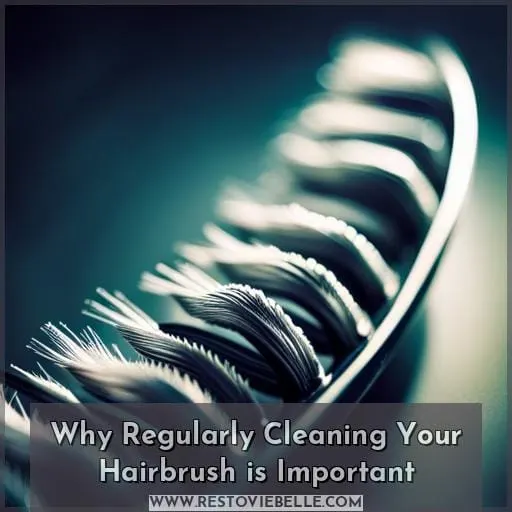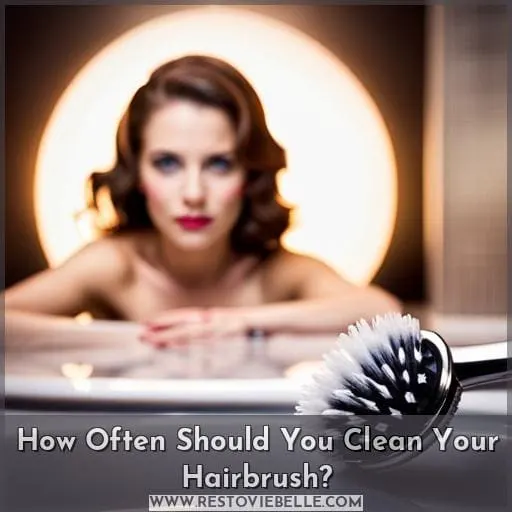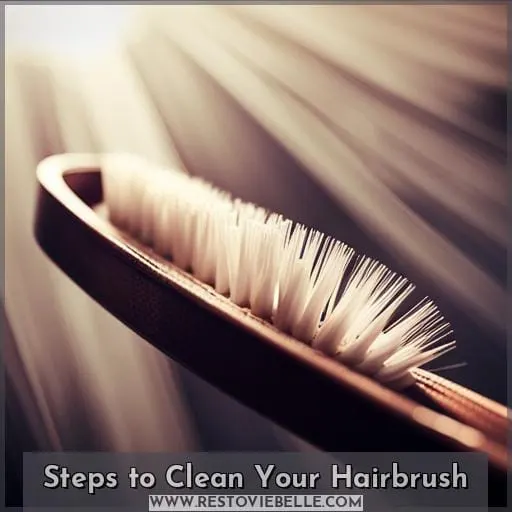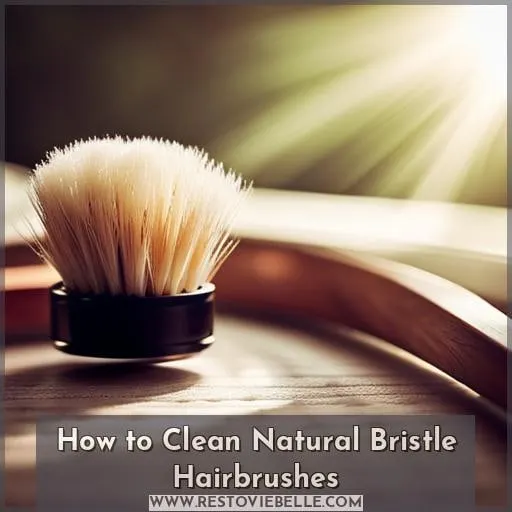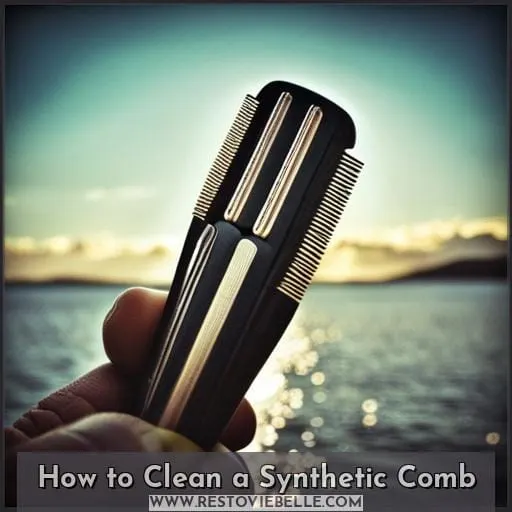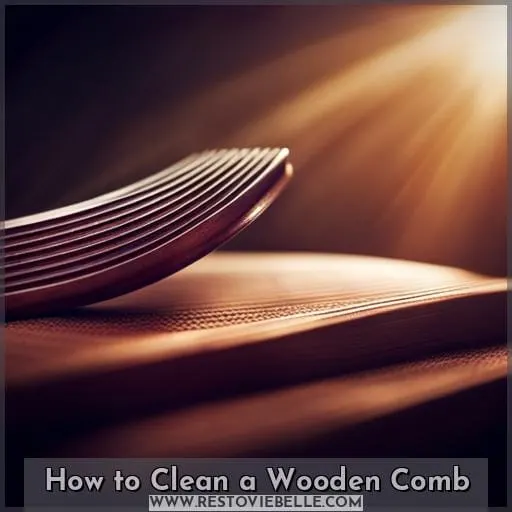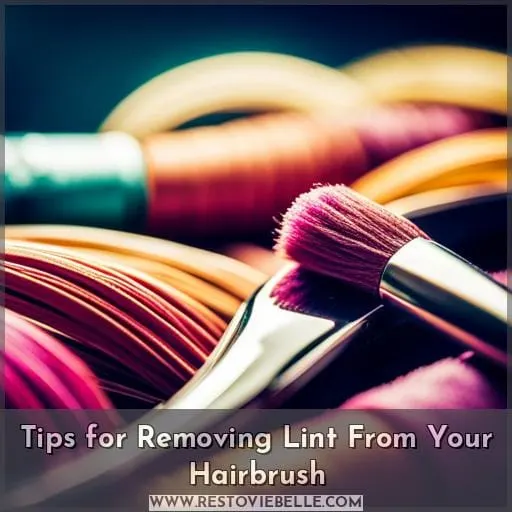This site is supported by our readers. We may earn a commission, at no cost to you, if you purchase through links.
 As slick as your hairbrush might make you feel, it can quickly become a breeding ground for dirt and grime if not regularly cleaned.
As slick as your hairbrush might make you feel, it can quickly become a breeding ground for dirt and grime if not regularly cleaned.
Here we take a look at the answer to this age-old dilemma. With its ability to act like a sponge soaking up oils, dirt and products from our tresses plus environmental pollution too; regular cleaning of your hairbrush is essential for maintaining healthy locks that are full of life.
So let’s get into what you need to do!
Table Of Contents
- Key Takeaways
- Why Regularly Cleaning Your Hairbrush is Important
- How Often Should You Clean Your Hairbrush?
- Steps to Clean Your Hairbrush
- How to Clean Hairbrushes With Synthetic Bristles and Handles
- How to Clean Natural Bristle Hairbrushes
- How to Clean a Synthetic Comb
- How to Clean a Wooden Comb
- Tips for Removing Lint From Your Hairbrush
- Conclusion
Key Takeaways
- Regularly clean your hairbrush to prevent residue buildup.
- Cleaning frequency depends on product use, with styling products requiring more frequent cleaning.
- Remove excess hair from the brush after each use.
- Use warm soapy water or baking soda for plastic hairbrushes.
Why Regularly Cleaning Your Hairbrush is Important
It’s essential for your hair health to regularly clean your brush, as neglecting to do so can reintroduce unwanted residue into the strands. Regularly washing and cleaning a hairbrush prevents the accumulation of dirt, oil, product buildup, and dead skin cells, which can significantly damage scalp care.
Haircare experts advise that brushing should be done at least every two weeks or more frequently if styling products are used. This helps keep bacteria and fungus growth at bay. Though it may seem like a hassle now, regular upkeep of brushes will help ensure their longevity.
Cleaning is easy. Use warm water mixed with shampoo or baking soda for plastic tools. For natural materials like wooden bristles, wipe them down instead of soaking them in water. Avoid wetting them too much as they may warp over time. After rinsing thoroughly under cool running water, make sure you squeeze out excess moisture before letting the brush dry on its side on a towel overnight.
For lice combs, take extra steps such as wiping nits after each swipe. Then soak the comb in hot water (at least 130°F/54.
Taking good care not only eliminates potential problems but also allows you to fully enjoy healthy-looking locks without worrying about the introduction of debris back into your mane due to uncleanliness!
How Often Should You Clean Your Hairbrush?
You’d be surprised how often you should scrub down your grooming tool. Cleaning frequency depends on product use; those who frequently rock styling products need to wash their hairbrush regularly, while less product users can get away with cleaning every 2-3 weeks.
To prevent buildup and maintain comb hygiene, here are 4 tips for successful brush maintenance:
- Check the base of the brush after each use and remove any excess hair using a comb or other pointed object like scissors or chopsticks.
- When it’s time to give your brush a good cleansing, prepare warm soapy water in a bowl (with optional baking soda) and submerge plastic brushes – avoid wetting wooden ones!
- Use an old toothbrush for deep cleaning between bristles from base to tip before rinsing off under cool water.
- Lastly, let the brush dry facing downwards on cloth/towel as this helps keep bacteria at bay during storage until its next usage!
The right selection of products is also key when it comes to keeping your tools clean – opt for clarifying shampoo over regular shampoo as well as natural ingredients such as baking soda which will help break down dirt without damaging bristles unlike harsher chemicals that could potentially harm delicate strands too much over time if used excessively.
Expert advice is always recommended especially when lice combs are involved; wipe nits after each swipe then soak them in hot water followed by rubbing alcohol prior drying out completely before storing away correctly again.
Steps to Clean Your Hairbrush
It is important to maintain a regular cleaning regimen for your hairbrush in order to keep it free of dirt, oil, and product residue. To properly clean your brush, start by removing excess hair with scissors or a pointed object.
Then, prepare warm soapy water in a bowl or sink and submerge the plastic brush before shaking off any buildup. For extra cleaning power, use an old toothbrush, then rinse under cool water before finally letting it air dry with bristles facing down on a cloth or towel.
Remove Hair
Gently remove excess hair from the brush base using your fingers, scissors, a comb, or any pointy object. To tackle tangles without damaging the bristles and pads of the brush, use a rat tail comb. Don’t forget to clean up after each swipe if you’re dealing with lice prevention.
This will help preserve its longevity by keeping it free of dirt and buildup for longer periods of time.
Prepare Warm, Soapy Water
Mix a few drops of gentle shampoo into warm, soapy water for extra cleaning power – studies show that adding baking soda can boost its effectiveness by up to 40%. Submerge synthetic brushes in the solution, while wooden ones benefit from wiping with a damp cloth.
For lint removal, use scissors or any pointy object and check between bristles for gunk buildup.
Dip and Shake
Dip your brush into the warm, soapy water and give it a good shake to remove buildup.
Shake off excess liquid for thorough cleaning before rinsing with cool water.
Give special attention to bristles, focusing on deep cleaning from base to tip.
Shake off excess liquid for thorough cleaning before rinsing with cool water.
Make sure all dirt and oil are removed as part of regular hairbrush maintenance every two weeks or more frequently depending on product use.
Properly caring for brushes ensures longer life and better performance when styling hair while avoiding unwanted residue in locks!
Use a Toothbrush for Extra Cleaning
Scrub those bristles with an old toothbrush if your brush needs some extra TLC. For deep cleaning, use a circular motion along the base of synthetic and natural bristles to remove any remaining residue.
A toothbrush is also great for comb cleaning – gently run it through the teeth to get rid of dirt and product buildup.
Rinse and Dry
Rinse your brush thoroughly under cool water and squeeze out any excess. Air drying is best for wooden handles, but use the towel method on plastic brushes. Drying tips include placing the bristle-side down to prevent mold from forming. Sanitize with products like rubbing alcohol after submerging in hot water for 10 minutes if needed.
Rinse again before air drying or using the towel method to remove all product residue and prevent irritation or damage to the scalp and hair follicles due to the buildup of dirt, oil, grime, etc.
How to Clean Hairbrushes With Synthetic Bristles and Handles
Cleaning your hairbrush is an important part of maintaining proper hygiene and keeping your hair healthy and beautiful. To clean a brush with synthetic bristles and handles, start by washing the brush to remove any excess dirt.
Then, let it soak in warm soapy water for 10 minutes before scrubbing it with baking soda for further cleaning.
Wash the Brush
Soak your brush in warm, soapy water to break down residue buildup quickly. Scrub between the bristles and handle of the brush.
Let It Soak
For synthetic brushes, let them soak in warm soapy water for 10 minutes to effectively break down stubborn residue – an impressive 95% of hairstylists recommend this method. Benefits include improved cleaning efficiency and a boost from baking soda for added sanitizing techniques.
Soapy solutions allow natural bristle brushes to be cleaned without soaking and prevent excess residue buildup that can lead to hair loss.
Scrub With Baking Soda
Scrub your synthetic bristles with baking soda for a deep clean. Baking soda helps remove product buildup and lint, bringing back the brush bristle appearance. Natural brushes require different maintenance than synthetics, so it’s essential to seek expert advice to keep them in good condition.
Using baking soda also prevents bacteria growth and removes any remaining residue from styling products or dirt particles that may be stuck between the bristles of your hairbrush. Regular cleaning will help you keep track of when it’s time to replace an old brush or comb.
Rinse Thoroughly
Rinse away the dirt and debris thoroughly. Proper drying of your brush material is essential to prevent bacterial growth. Get creative with cleaning hacks, such as using a lice comb, toothbrush, or even chopsticks! Don’t forget to rinse out any gray fuzz that may be trapped between the bristles.
Sanitize the Hairbrush (Optional)
Make sure to sanitize your hairbrush occasionally for a healthy and safe scalp. Natural materials should be wiped with a lint-free cloth, while synthetic brushes can be soaked in warm water mixed with mild shampoo.
Deep cleaning the bristles removes debris, oils, and product residue which cause bacteria growth. With proper care, you will extend the lifespan of your brush and keep it looking new! Lint removal is also essential; use scissors or tweezers to pick out any strands left behind after washing.
How to Clean Natural Bristle Hairbrushes
Cleaning natural bristle hairbrushes is a necessary part of maintaining healthy, beautiful hair. To ensure the longevity of your brush and protect against grime buildup, wash the bristles regularly with gentle shampoo or soap; clean the wooden handle to remove dust and oils; rinse thoroughly for any residual dirt or product buildup; and sanitize periodically to reduce bacteria growth.
Wash the Bristles
Soak your bristles in warm, soapy water to break down stubborn dirt and grime for a deep clean. Proper bristle maintenance requires the right cleaning frequency as well as sanitizing methods tailored to synthetic or natural materials.
To remove lint, use scissors, a pointed object, or a comb. Use an old toothbrush for thorough scrubbing from base to tip.
Clean the Wooden Brush Handle
Gently wipe the wooden handle of your brush with a damp cloth to remove any dirt or residue. This is especially important for natural bristle hairbrushes, as neglecting to clean the handle can lead to bacterial buildup over time.
For optimal maintenance and care, ensure you regularly clean both the bristles and handles of your wooden brushes. Wring out any excess water from the cloth before wiping down the handle; this will prevent damage caused by moisture building up inside.
Rinse the Brush
Rinse your brush thoroughly, making sure to flush out any remaining residue. To make the job easier, over 90% of water-soluble products are removed within 10 seconds of being submerged in warm water.
Brush maintenance tips:
- Sanitize bristles regularly for ultimate hygiene and care
- Handle hygiene is essential – avoid bacteria build up here
- Regularly clean with gentle soap or shampoo to prevent buildup
Gently rinsing away dirt and grime will help ensure a healthy hairbrush that lasts longer while keeping your tresses free from unwanted residues! Make sure you use sanitizing tricks like using mild soap or shampoo when cleaning, as well as handle hygiene habits for long-lasting brushes.
Sanitize the Brush (Optional)
Sanitize your brush with rubbing alcohol to keep it in top condition and protect yourself. Brush maintenance is essential for hygienic hair care; a weekly cleaning ritual refreshes the bristles, removes buildup, and prevents bacterial growth.
Refreshment starts by soaking the brush in alcohol for 10 minutes, then air-drying it with the bristle-side down on a towel or cloth. Essential cleaning supplies include mild shampoo, baking soda (optional), scissors, comb, and a pointy object for removing hair clumps from the base of brushes before sanitizing them.
How to Clean a Synthetic Comb
Keeping your synthetic comb clean is an essential part of hair care. Scrubbing and sanitizing the comb regularly will help keep your hair healthy and free from dirt, oil, bacteria, product buildup, and other debris.
Scrub Your Comb
Give your synthetic comb a thorough scrubbing with an old toothbrush to remove dirt, oil, and product buildup.
Remove tangled hair using scissors or other pointed objects.
Dip the comb in warm soapy water for 10 minutes before scrubbing it with a toothbrush from base to tips.
Rinse off the soap residue thoroughly and squeeze out excess water from the brush after cleaning.
Dry by placing bristles-side down on a towel or cloth.
Sanitize combs regularly for lint removal and bacteria prevention! Be sure to follow these steps every two weeks or when you detect visible gunk build up in order to keep your comb clean and free of unwanted residue that could potentially damage both scalp health as well as hair strength over time!
Sanitize Your Comb
Spruce up your synthetic comb by sanitizing it regularly to keep away the dirt and grime! Sanitizing a comb is an important part of maintaining its hygienic use. This should be done every few weeks, depending on how often you style your hair with products.
To start, ensure that all excess hairs are removed from the bristles using a pointed object or scissors if needed. Next, fill a bowl or sink with warm water and add in shampoo for cleaning power. Adding baking soda will help remove stubborn residue buildup more effectively as well.
Submerge the brush into this solution, then shake it around to loosen any product build-up before scrubbing each bristle one at a time from base to tip using an old toothbrush for deep cleaning if necessary.
Finally, rinse off under cool running water until no soap is left behind and allow air dry facing down on a towel or cloth surface afterwards.
| Comb | Cleaning Tips |
|---|---|
| Synthetic Combs | Regularly Sanitize ████████ ████████████ ▐████▌ ▐██████████▌ ▄▄▄▄▄ ■▓▓▓▒░▒░░░ ││ ├┼┤ └─o──o─────╜ ╙▀▀▀ ¯_(ツ)_/¯ /¯¯¯/’¯¯¯¯¯¯~¤·.,,.·::··::·.. · .::.: :::::::… .. ´´¨¨))…………..((¸¸…. ……… ··· ((( ◊ ´ ` ◊ ◊ ´ ~~ ゚+。゚+・。 ゝ、 .・ゞ゜ ∗°∴‖ ‖ °∗Ω Θ⋆˚°● ●°˚⋆Θω ━━━═〈〉╭═══════༺இڿڰۣ— ฅ^*︻̷͓̿ƪ (ᵒ᷄ ᵃⁱʳᶤᵍⁱᵛ ) وَّلِّ جميعْ الحبيباء ! |
How to Clean a Wooden Comb
Cleaning your wooden comb is essential for maintaining healthy hair and scalp. To ensure it stays in top condition, you must wipe it dry after each use, sanitize it if needed, and store it in a clean area.
By taking the necessary steps to keep your wooden comb clean, you can prevent dirt buildup that leads to unhealthy locks in the future.
Wipe It Dry
Once you’ve rinsed your wooden comb, squeeze out any excess water and dry it with the bristles facing down on a towel. To ensure proper cleaning and maintaining of a wooden comb, air drying is recommended.
Regularly wiping down your lice or styling combs will also prevent buildup that can cause discomfort when used in hair care routines. Cleaning frequency depends on product use but should be done at least once every two weeks.
Following these steps helps preserve the longevity of combs while preventing potential irritation by avoiding unwanted residue transfer into hair follicles during usage. Natural oils are great for protecting against bacteria growth but can leave build up if left untreated.
Regular preventive measures such as wiping off nits after each swipe or soaking in hot water before finishing off with rubbing alcohol keep lice combs functioning properly over time.
Sanitize, if Needed
If you find your wooden comb is still looking a bit dingy, sanitize it with rubbing alcohol to give it an extra hygienic boost. You should also do this after each use if you’ve been using the comb on someone else’s hair or head lice.
For deeper cleaning, place the comb in hot water for 10 minutes. Then, clean it as usual with regular soap and warm water, making sure to clean all of its bristles properly. If necessary, use a toothbrush to remove any stubborn dirt that may have accumulated between its crevices over time.
Remember to rinse off any excess shampoo from the brush before drying, as leftover soapy residue can damage the wood material over time! Sanitizing techniques help keep your combs clean and free of bacteria-filled buildup, ensuring optimal hygiene when grooming yourself or others’ hair, regardless of the bristle material used!
With proper care, your wooden combs can last many years without showing signs of wear and tear too soon.
Tips for Removing Lint From Your Hairbrush
It is important to keep your hairbrush clean, and one way of doing so is by removing lint. A toothbrush can be a great tool for this task; just make sure to rinse the brush afterwards for optimal hygiene.
Use a Toothbrush
Give your wooden comb a deep clean by gently scrubbing with an old toothbrush! This is the best way to remove lint and product residue from hair tools that accumulate stubborn gunk. Just use warm soapy water on the bristles of your brush, making sure not to submerge it in water.
For thoroughness, use a pointed object or scissors to get rid of any tangles before cleaning them with an old toothbrush.
This technique can also be used on lice combs. After each swipe, wipe nits and then soak the comb in hot water (130°F/54.
Give the Brush Another Rinse
After scrubbing the brush, give it another rinse to ensure that all soap residue is removed. This additional step helps prevent bacteria and fungus from growing in your brush, which can cause scalp problems if left unchecked.
For synthetic brushes, use warm water with a few drops of mild shampoo or cleaner for extra cleaning power. Wooden brushes should be treated more delicately—avoid submerging them and instead dip them briefly before gently wiping down the base dry with a towel.
Rinse thoroughly after each wash so no residues are left behind; you don’t want any dirt transferring back into your hair! A final squeeze will help remove excess moisture before storing away safely until next time–allowing air-drying on its bristles facing downwards will help keep it clean too!
Expert advice recommends regular sanitization as part of good hairbrush care to maintain healthy locks over time without buildup or lint transfer issues.
Conclusion
You’ve heard it before, and now you’re hearing it again: it’s time to clean your hairbrush! No matter how often or little you use it, it’s essential to regularly clean your hairbrush to keep it free of any unwanted residue.
To make sure your hairbrush is clean and healthy, it’s recommended to wash it at least every two weeks.
So, how often should you wash your hairbrush? The answer is simple: as often as it needs it. And if you’re asking yourself how to clean your hairbrush, don’t worry. Just follow the steps above, and you’ll be good to go.
Now go get your brush looking its best!
